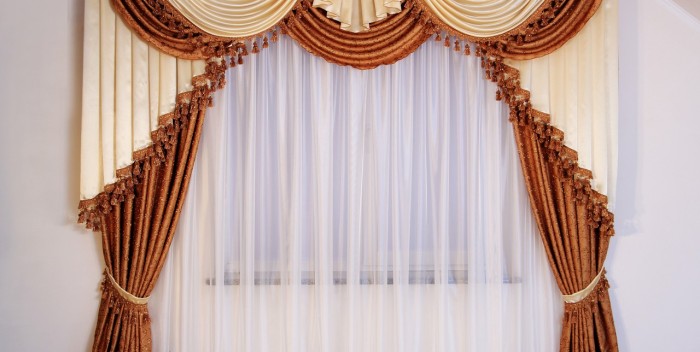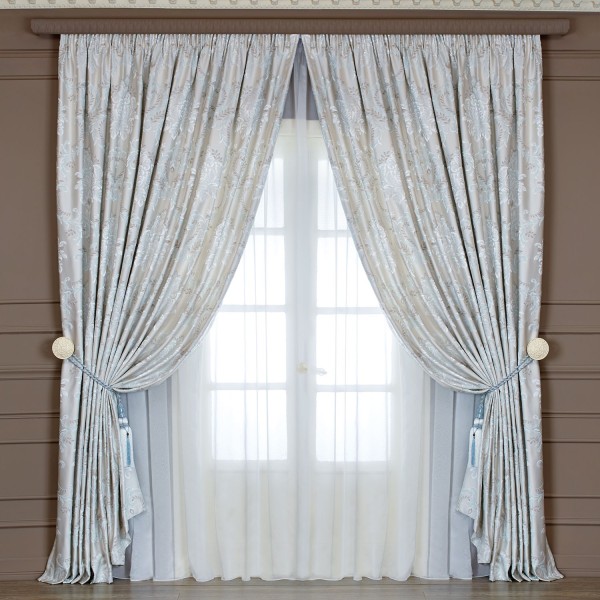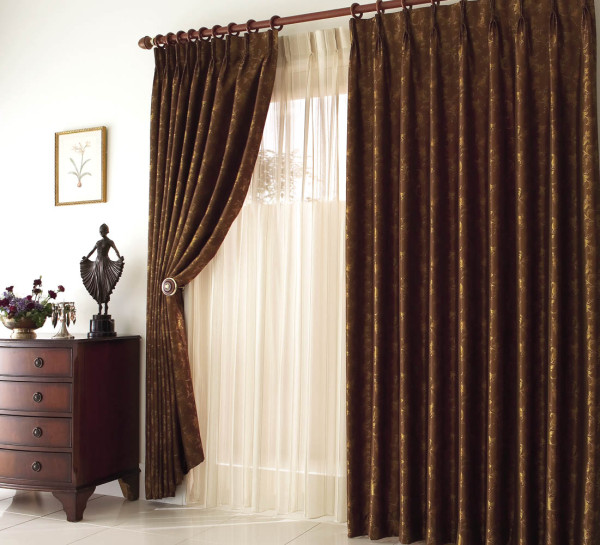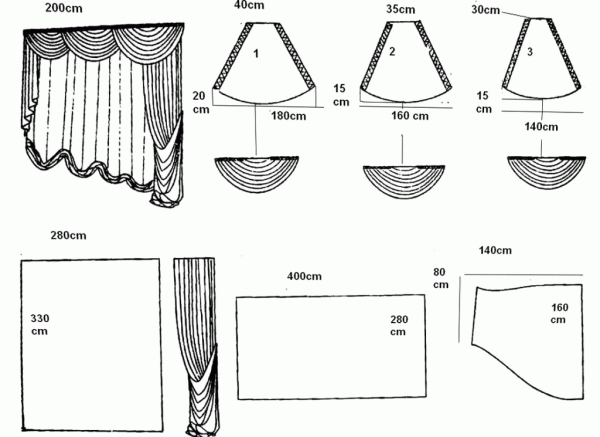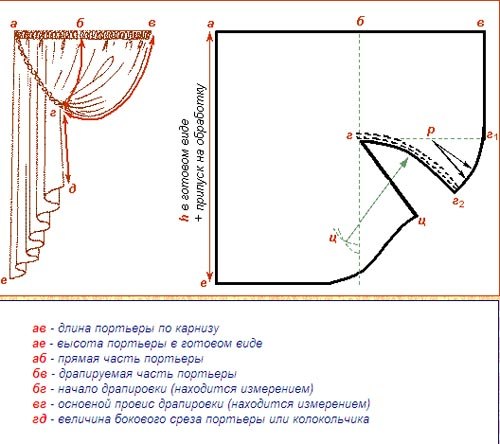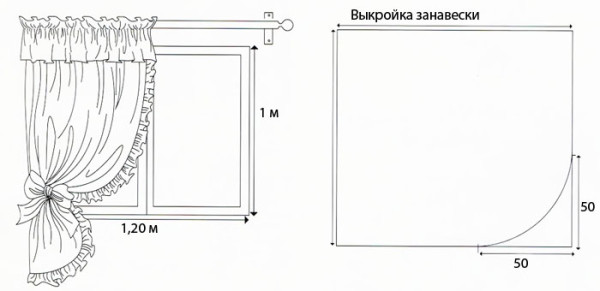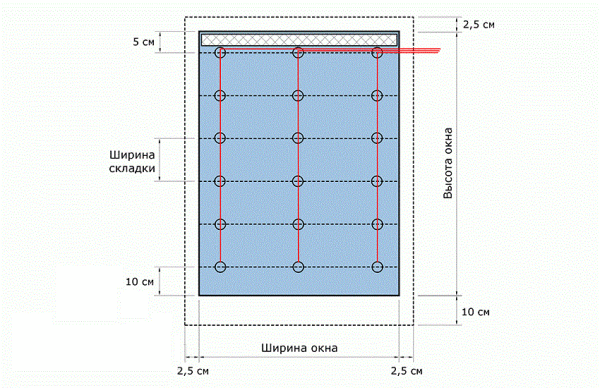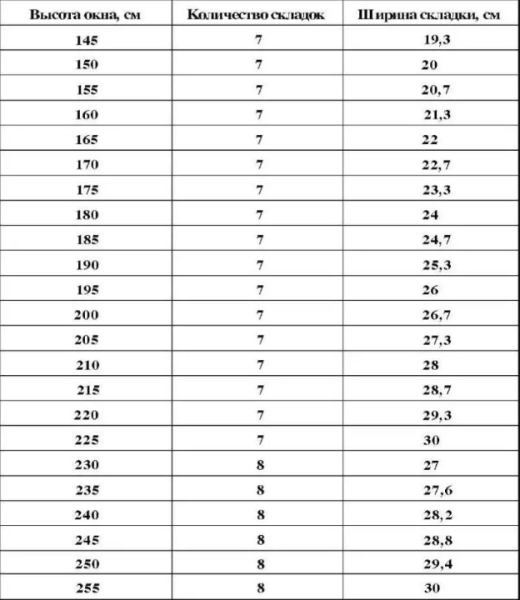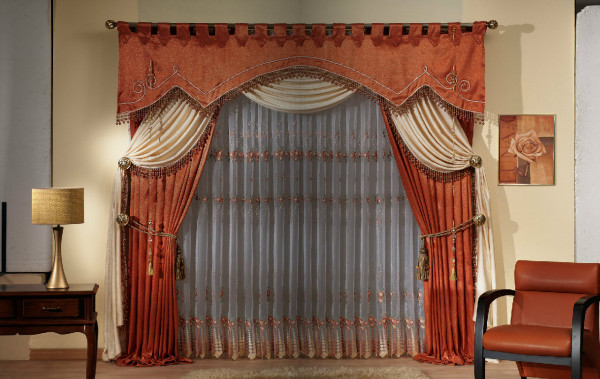How to sew curtains
Curtains are a decoration of every room, even in the kitchen, many prefer to decorate windows in this way to create additional comfort. Despite the fact that blinds or the complete absence of some elements on the window are becoming more and more fashionable every year, there are still "old-fashioned" people who still consider curtains an important attribute. interior... In this article, we will consider how you can sew different versions of curtains with your own hands and what material is better for this.
Content
Sizes of curtains
To determine the size of the curtain, you need to take some measurements. The basic data is width and length. Keep in mind that all measurements must be carried out after the cornice has been purchased and installed, because they are different and hang them at different levels. Then take a tape measure and measure the width and height. The width is measured from the attachment to the attachment of the curtain rod, and the height from the curtain rod to the desired curtain length. Consider the fastening of the curtains, since, for example, if curtains on the eaves are held on rings, then the height is taken with a margin.
Now you need to concretize the data obtained, because if you sew the curtains according to the available measurements, then it will be a simple hanging canvas, and the drapery looks much more beautiful. When deciding on the degree of drapery, you need to take into account some points:
- if the area of the bedroom or living room allows it, then the volumetric drapery will add lightness and airiness to the living room;
- for rooms with a small area, the drapery should be weak, otherwise it will make the "image" heavier.
With this in mind, calculate the width of the curtains according to the following principle:
- For a weak drapery, multiply the width obtained during measurements by 1.5-2.
- To obtain a volumetric drapery, multiply the obtained calculations by 2.5-3.
If the curtains consist of two panels, then another 15 cm is added to the resulting length. This is done so that when the window is closed with curtains, the panels are superimposed on each other and the room is darkened. You can use another method to calculate the width of the curtain fabric:
- if the width of the cornice is less than 1.4 m, and this often happens in kitchens, then the width of the curtain is exactly the same size, i.e. it will be an ordinary curtain;
- if the width of the cornice is from 1.5 to 2 meters, then the width of the curtain must be multiplied by 1.5;
- with a cornice of 2-2.8 meters, the width of the curtain is multiplied by 2, i.e. will be 4-5.6 m;
- cornice 2.8-3.4 meters requires a curtain, the width of which will be 2.5 times greater;
- the largest increase occurs with a cornice of 4 meters, in this case the width increases by 2.5, or even 3 times.
The width of the curtains largely depends on their design, so this factor must also be taken into account. Drapery is appropriate for light fabrics; on heavy materials, you should not be zealous with this decorative element.
If we are talking about roller blinds and roman blinds, then their width is almost always the width of the window opening.
The length of the curtain is determined by the tastes and preferences of the owners of the apartment, although the designers advise keeping a reference point on where the curtain will hang. For example, in the kitchen it is irrational to make a curtain, much lower than the level of the windowsill. In the bedroom and living room, it is recommended not to reach the floor level of 3-4 cm.If you want the curtains to fall effectively to the floor, then you need to add from 20 to 50 cm to the measured data, depending on the specific design.
Pattern of curtains
There is simply no single pattern for sewing curtains, due to the huge choice of very different designs, so you will have to navigate yourself, for this you just need to turn on your imagination, because there is nothing complicated in this process. Below are schematic patterns that will help you move in the right direction.
How to sew Roman shades
Roman blinds are very simple, laconic and elegant at the same time. They do not imply the presence of drapery, and due to their straightness, the pattern of the fabric will be visible without distortion. The material consumption for such a curtain is very small, which means that beautiful remnants of fabric can be used, which the hand does not rise to throw away.
When choosing a material, be sure to pay attention to the light transmittance of the fabric. Before sewing the curtain, you need to decide how it will be attached - this will also help to calculate the material consumption. There are two options:
- The first one is inside the window opening, then the fabric will adhere to the window.
- The second - the mount falls on the outer edge of the window. This method is the most popular, since in this case the windows can fully swing open if it is necessary to ventilate the room. With this option, the curtain extends beyond the window by 10-15 cm.
It will not be difficult to make a simple Roman blind with your own hands, this will require:
- Velcro tape - the length is equal to the width of the curtain;
- wooden weighting bar and for hanging curtains;
- nails and hooks;
- three cuts of the cord - the length of which is taken from the calculation of the width of the curtain + 2 lengths of the curtain;
- plastic rings, a couple for each drawstring, a lace will pass through them;
- 7-8 metal or wooden pins, the length of which is 3 cm less than the length of the curtain;
- curtain material and lining.
Measure the window opening and add to the obtained data five centimeters for the side seams and 12 centimeters for the top and bottom for the seam allowances. You need to calculate the number of folds. It is easier to do this if you focus on the table below.
- On the wrong side of the fabric, mark the fold and fold lines, as well as the places where the rings will be located. It is very important to accurately and evenly measure the location of the folds, otherwise there will be no beautiful drapery.
- Overlock the side edges of the shade.
- Fix the Velcro on the underside of the wooden block with a furniture stapler or studs, the curtain will be attached here. Process the upper part of the curtain and sew on the remnants of the Velcro. In the future, this will help to remove the curtain for washing.
- Tuck the bottom of the curtain to the width of the pocket so that you can insert the weighting stick.
- Run the machine stitch on the wrong side of the curtain and insert the slats into the resulting pockets.
- Mark the position of the rings and fix them manually. On the wooden part of the curtains, the rings are fixed with nails.
- Install the curtain on the bar using Velcro. Secure the lace fastener to the window frame and wrap the cord to secure the shade. Starting at the very bottom, start threading the cord into the rings, tie a knot at the bottom end and grease it with glue for strength.
- Pull the cord through all the rings at the very top, do the same with the other rows. Then pull all the cords tight enough to distribute all the wrinkles. The latter must be fixed in this position with the help of the braid.
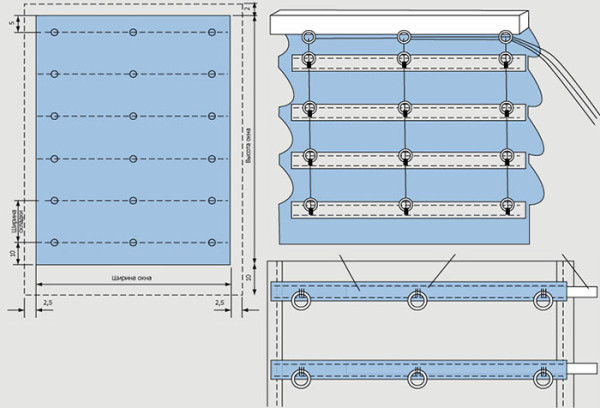
- Tips fix the timber on the window frame, remove the tape that held the curtain. It will go down, after which you need to even out the tension of the laces. Holding them together, you need to tie a knot so that it is at the last ring. Pull the cord through the lifting handle and after 40-45 cm from the first knot tie the second one, the rest of the cords can be cut off.
- Place the cord anchor on the window frame and wrap the cord to secure the shade.
That's it, the Roman shades are ready!
How to sew simple curtains
Simple curtains are even easier and faster to sew. For this you will need:
- fabric (we will tell you what material is suitable for this further);
- scissors;
- threads to match;
- tape for curtains;
- chipping needles;
- iron;
- crayon;
- sewing machine.
Material consumption is calculated based on measurements that were made earlier. First draw the dimensions of the panel on paper, you don't have to do this if it is more convenient for you. Lay out the fabric (it is advisable to decorate the fabric before cutting it out) and transfer the cutting pattern to it. Do not forget to take a stock of 2-3 cm for processing and hemming, to the bottom you need to make an increase of 5 cm in order to bend the edge qualitatively. Cut out a piece of curtain in one unit - you can divide it into two after hemming.
Fold the bottom of the curtains by the same 5 cm and lay a straight line. This width acts as a kind of weighting agent, due to which the curtain will look more beautiful.
Now fold the material in half lengthwise and cut into 2 pieces (two curtains). Close the side seams of the halves.
Finish the top of the curtain and sew on the curtain tape. Instead, you can use rings - here it is as you like. It remains only to iron the curtains thoroughly and hang them in their place.
This is a classic version of curtains that will be appropriate everywhere.
How to sew curtains with your own hands
In conclusion, it is worth paying special attention to the fabrics that are used when sewing curtains. Not only the appearance of the textile will depend on this, but also its durability and many other factors. So, the most suitable curtain fabrics are:
- Linen. A very durable material that can last up to half a century. It can be both dense, rough, and thin, delicate, it all depends on the specific manufacturing technology. The big minus of this material is that it wrinkles very quickly, but it is very problematic to iron. When choosing linen as a material for curtains, you need to remember that it shrinks a lot, so it is imperative to decorate it. The material is expensive, but the quality is worth it.
- Natural silk. Very expensive, both for the price of the material and for the care. Firstly, it is very picky, and secondly, when sewing curtains from it, you need to use a lining. Otherwise, after two hundred hours of sunshine, it will begin to fade.
- Viscose. A good alternative to silk. It is several times cheaper and not picky about sunlight, and the wear resistance is also good, although the lining is still better to use.
- Velvet. Curtains made of this material look very expensive and cozy, but the disadvantage of such curtains is that due to the available villi, dust settles on them very quickly. And this already requires frequent care of them and is not very good for allergic.
- Jacquard. Beautiful and even chic material, durable and reliable. You can sew not only curtains from it, but also linens and pillows. It will be very beautiful if you sew a sleeping set and curtains from this material of the same color, only such a set will result in a pretty penny, but such a combination will definitely delight the eye.
Other materials from which curtains can be lived: taffeta, satin, black out, organza, muslin, micro veil, mesh. The specific choice of fabric depends on the type of room where the curtain is sewn, design and, of course, financial capabilities.
